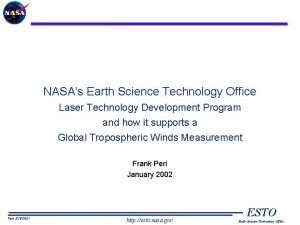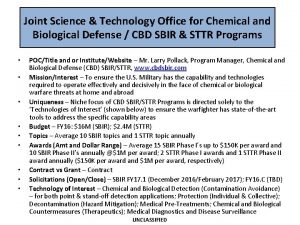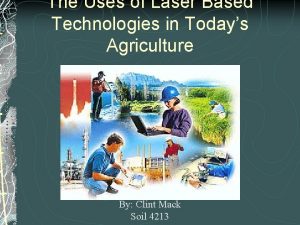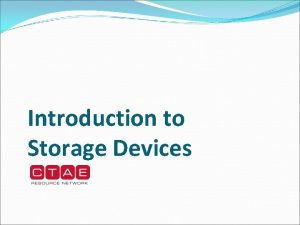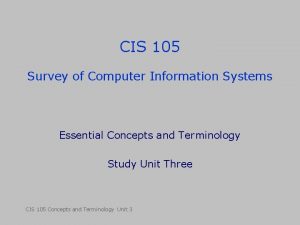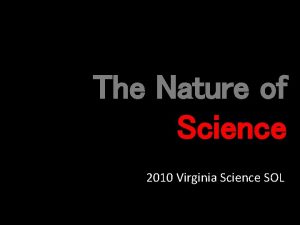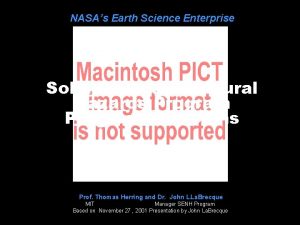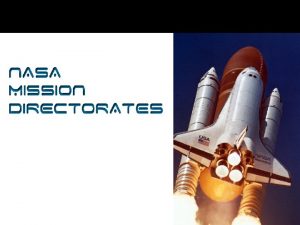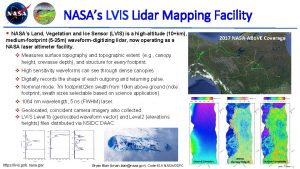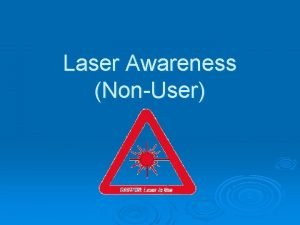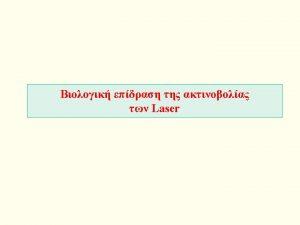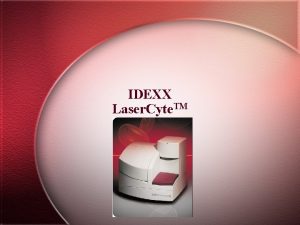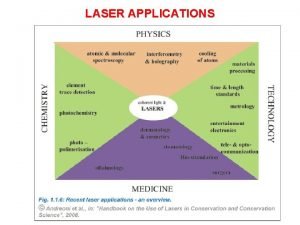NASAs Earth Science Technology Office Laser Technology Development











- Slides: 11

NASA’s Earth Science Technology Office Laser Technology Development Program and how it supports a Global Tropospheric Winds Measurement Frank Peri January 2002 Peri 2/25/2021 http: //esto. nasa. gov ESTO Earth Science Technology Office

Integrated ESE Lidar Strategy Noncoherent DIAL CO 2 Pulsed Laser Development Coherent Ocean/River Surface Currents 2 MICRON C O M M O N Diode Pumping Architecture Single Frequency Electrical Efficiency Heat Removal Ruggedness Lifetime Graceful Degradation 1 MICRON Atmosphere: Lower Upper Coherent Winds High Accuracy High Resolution Lower Trop. & Clouds Hybrid Lidar Winds X 3 Noncoherent Winds Global Coverage Medium Resolution Medium Accuracy Mid/Upper Atmosphere 0. 355 micron Pump OPO 0. 30 -0. 32 micron Noncoherent DIAL O 3 Higher Power Altimetry Laser Peri 2/25/2021 http: //esto. nasa. gov ESTO Earth Science Technology Office

Origins • In January 2001, a memo from the AA’s of Code Y and R requested that GSFC and La. RC jointly respond to three separate actions. These are quoted and listed in their order of appearance in the letter: – “and for GSFC and La. RC together to define the plans for working together on areas of mutual interest in laser development in a complementary way. ” – “GSFC and La. RC must define how Centers will cooperate on future lidar competitive opportunities, in order to be able to fully participate in an integrated Agency research and development strategy for lidar technologies. ” – Define “a GSFC/La. RC lidar working agreement as well as a description of your envisioned role in the Agency research and development strategy for lidar technologies/ Laser Development Steering Group. ” • In addition, in November 2000, the findings of the Independent Laser Review panel were published which included, amongst others, the creation of a “Space Laser Super Center” managed as a single organization at the NASA HQ level. • La. RC and GSFC have formed a joint working team, the NASA Integrated Lidar Systems Strategy Team (NILSST), in response to these findings and requests. • ESTO adopted findings from these teams to create Laser Technology Program. Peri 2/25/2021 http: //esto. nasa. gov ESTO Earth Science Technology Office

FY 02 Joint Laser Technology Program Task Synergies Laser Risk Reduction Program (LRRP), Code-Y $ 2 M • 2 -micron Laser Transmitter • Laser Diodes (795 -792 nm) • Wavelength Conversion Enabling Concepts and Technology Program (ECTP), Code-R $ 2. 1 M 2 -Micron Laser Transmitter • • • Code-Y ATIP Breadboard CO 2 DIAL Breadboard WIND Transmitter 2 -um Detector Development Receiver Subsystem Multi-Use Lidar Transmitter 3 -9 um Quantum Mechanical Modeling and Advanced Materials Wavelength Conversion La. RC GSFC LRRP, Code-Y ECTP, Code-R $ 1 M $ 2 M • 1 -micron Laser Transmitter • Laser Diodes (808 nm) • Injection Seeding for Wavelength Control NRA Awards Code-R $ 0. 9 M Code-Y $ 0. 6 M 1 -Micron Laser Testbed • • • Laser Architecture/System/Components Opto-mechanical design Contamination Damage Tolerance Heat Removal Environmental testing • Laser Diode for DIAL • High Power Laser • Multi-Use Lidar Transmitter, 3 -9 um Code-R CETDP Water Vapor DIAL Code-Y ATIP NRA Awards Code-R $ 0. 3 M Semiconductor Laser Source Code-R CETDP

Summary of Tasks Laser Transmitter Task ($1. 1 M) Develop high-energy, high-efficiency, conductively-cooled, 2 -micron pulsed laser. Develop high-efficiency, solid-state seeder for single frequency operation of high power lasers Laser Diode Array Task ($1. 4 M) Address issues associated with diode laser array pumps for solid state lidar transmitters. Collaborate with industry and perform specialized testing to ensure technical and commercial availability of laser diodes for pumping of efficient, solid-state lasers in future NASA missions Wavelength Conversion Task ($1. 5 M) Develop wavelength conversion technologies to convert energy from laser pumps to efficient, high-energy, tunable, pulsed and CW energy in UV and IR. Develop injection seeding for wavelength/linewidth control Peri 2/25/2021 http: //esto. nasa. gov ESTO Earth Science Technology Office

Laser Transmitter Task Objective Develop a high-energy, high-efficiency, conductively-cooled, 2 -micron pulsed laser. Develop a diode laser-based seeder for single frequency operation of high power lasers Rationale/Applicability 2 -micron applicable to Trop Winds and CO 2. Seeder applicable to nearly all laser applications. Description of Task Develop a laser with conductively-cooled laser diodes; develop a thermal and optical simulation of the laser head; design and fabricate a fully conductively-cooled laser head; and design a compact, hardened laser. Develop a diode laser based seeder, externally tuned with an electro-optic KTP crystal Deliverables Working laser with CC laser diodes; thermal/optical laser head simulation; bonding procedure knowledge; fully CC laser head. Working seed source with better than 50% efficiency. Peri 2/25/2021 http: //esto. nasa. gov ESTO Earth Science Technology Office

Laser Diode Array Task Objectives Address issues associated with diode laser array pumps for solid state lidar transmitters. Collaborate with industry and perform specialized testing to ensure technical and commercial availability of laser diodes for pumping of efficient, solid-state lasers in future NASA missions Rationale/Applicability LDA’s used in all solid-state lasers. Description of Task • • Develop laser diode requirements Conduct technical interchanges with laser diode vendors and with the Air Force Procure initial selection of LDs Perform initial LD tests and analyses Roles and Responsibilities La. RC: Diode Lasers operating at 790 -795 nm for pumping 2 -micron lasers GSFC: Diode Lasers operating at 808 nm for pumping 1 -micron lasers Approach • • Define operational, physical, and environmental requirements Establish working relationships with Industry and DOD Collaborate and exchange data between GSFC and La. RC Provide input to diode laser manufacturers Peri 2/25/2021 http: //esto. nasa. gov ESTO Earth Science Technology Office

Wavelength Conversion Task Objective Develop wavelength conversion technologies to convert Nd: YAG laser into an efficient, high-energy, tunable, pulsed UV laser in the 280 – 320 nm range, Rationale/Applicability 280 -320 nm used for ozone, techniques also relevant for direct detection winds (~355) and for water vapor (~944) Description of Task • • Develop a high-power OPO/OPA/SFG at 320 nm Develop a stable, injection-seeded OPO cavity for use in a high-power laser Develop a tunable, single-mode CW seed source capable of tuning from 600 nm to 950 nm, frequency doubling NIR fiber laser Develop a high average power (>20 W UV) OPO without using high-energy pulses, with small-diameter beam (~2 mm), and high conversion efficiency (>12%) from the IR to the UV Deliverables • • • CW seed source requirements 150 m. J OPO/OPA/SFG system Lifetime and stability of non-linear materials Space qualification studies for fiber lasers Flashlamp-pumped Nd: YAG laser with high beam quality (M 2<2) Nonlinear optics module to convert 1064 nm to 310 nm with 12% conversion efficiency Peri 2/25/2021 http: //esto. nasa. gov ESTO Earth Science Technology Office

Trop Winds Measurement Current Facts • • • Laser transmitter technologies for application to space-based instruments are not mature enough to begin a formulation activity User community believes that NASA must invest in lidar technologies, including laser transmitters and receiver technologies, including telescopes, scanners, detectors and filters. Databuy no longer only solution. Current investments by ESTO are insufficient to ensure successful operational trop winds mission formulation Strategy • • Use hybrid measurement approach as strawman plan for technology activities Objectives of this technology development activity are to show progress towards enabling a space-based tropospheric winds measurement to OMB in support of FY 04 -10 funds formal formulation activity Peri 2/25/2021 http: //esto. nasa. gov ESTO Earth Science Technology Office

Hybrid Wind Lidar Technology Plan Coherent - better in cloudy situations • Uses returns from aerosols (and cloud particles) • High accuracy and spatial resolution when signal is above design threshold (sensitivity challenged) • Complexity & cost scale to sensitivity (coverage) Laser Program Direct - better in cloud-free upper troposphere • Uses returns from molecules (constant target) • Acceptable accuracy and coverage in mid and upper trop but performance reduced by clouds and aerosols. • Size and costs scale to desired accuracy/resolution $3 M Code R Implementation Options $4 M ESTO NASA/IPO build Ground Validation Direct 0. 355 mm Altitude (km) 20 Technology available for science NMP measurement validation in space Infusion to commercial entity A/C Demo Coherent 2 mm 15 20 Vertical Coverage 10 5 0 10 0 GSFC La. RC Conical Scan Depicted Wind Error Resolution Year Peri 2/25/2021 Data buy 1 2 3 4 5 http: //esto. nasa. gov 6 7 8 Mature technologies relevant to space-based measurement capability, airborne measurement demonstration, verify algorithms, account for platform motion effects, mature operations approach 9 10 ESTO Earth Science Technology Office

Other Applicable Technology Programs • NOAA earmarks to NESDIS (Periera) and OAR (Hardesty) • IPO effort lead by Chief Scientist (Mango) • Do. D work ongoing NASA is ready to start discussions with partner organizations on a technology plan. Peri 2/25/2021 http: //esto. nasa. gov ESTO Earth Science Technology Office
 Solearth
Solearth Joint science and technology office
Joint science and technology office Her favorite subject is math
Her favorite subject is math Science fusion digital lessons
Science fusion digital lessons Conclusion of laser technology
Conclusion of laser technology Introduction to storage
Introduction to storage Storage device that uses laser technology
Storage device that uses laser technology Office and factory
Office and factory Meteorological symbols for four types of fronts
Meteorological symbols for four types of fronts Earth science sol 2010
Earth science sol 2010 Earth science regents lab practical review
Earth science regents lab practical review Earth science regents lab practical
Earth science regents lab practical
